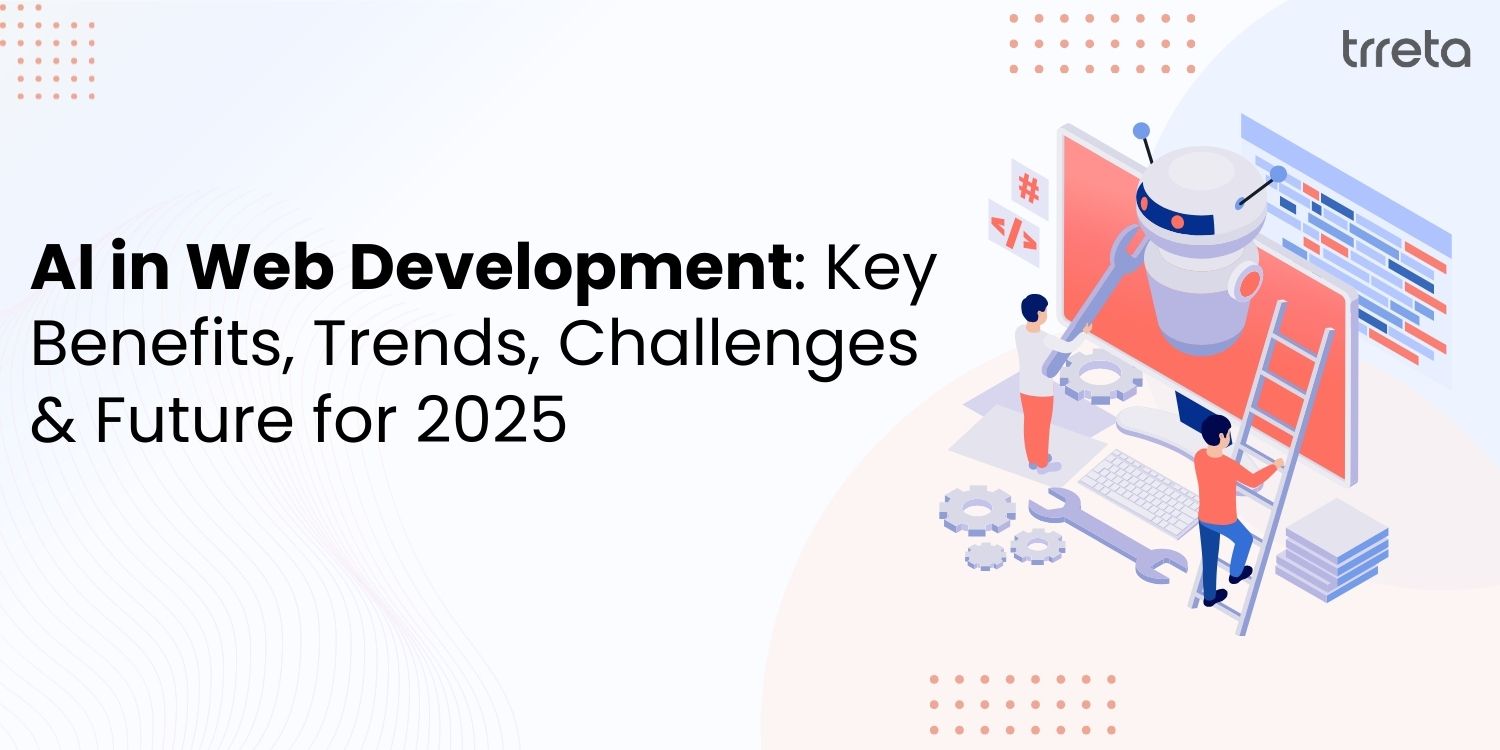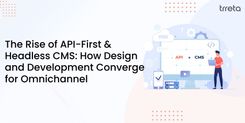The internet has never stood still. We’ve gone from static pages in the ’90s to dynamic content, mobile-first designs, and now, we’re entering an era where websites can think, learn, and adapt in real time. That leap is powered by Artificial Intelligence — and in 2025, its influence on web development isn’t just a trend, it’s a transformation that’s redefining how businesses connect with their audiences.
For years, building a website was a straightforward but labor-intensive process: plan the architecture, design the UI, write the code, launch, and then manually tweak it as needed. But today’s reality is different. Websites can write parts of their own code, detect and fix UX bottlenecks without human intervention, recommend tailored products to every single visitor, and even predict which changes will increase conversions — all because AI is woven into the development process.
In this in-depth exploration, we’re going beyond the buzzwords. We’ll break down the practical benefits of AI in web development, the current trends shaping the industry, the real obstacles teams are facing, and where the technology is likely headed over the next decade. You’ll also see real-world case studies, fresh statistics, and industry insights — the kind you can actually use to make smarter business and tech decisions.
What AI in Web Development Actually Means
When people hear “AI in web development,” they often imagine robots typing out HTML or design tools that magically create perfect layouts. The truth is more layered and, frankly, more exciting.
At its core, AI in web development refers to the integration of machine learning models, natural language processing (NLP), computer vision, and automation frameworks into every phase of building and maintaining a website. This means AI isn’t just a tool you plug in at the end of a project; it’s a partner in the development journey.
A few concrete examples of what this looks like today:
- AI-powered code generators like GitHub Copilot suggest entire code blocks, not just syntax completions, drastically reducing repetitive tasks.
- Design intelligence tools such as Figma’s AI features can instantly generate wireframes or adapt layouts for multiple devices.
- Predictive analytics systems can analyze visitor data to forecast traffic surges or pinpoint why a certain landing page is underperforming.
- Conversational AI chatbots can handle customer inquiries around the clock without sounding robotic or losing brand personality.
In other words, AI is no longer an optional “add-on” to web development. It’s becoming a structural pillar — much like responsive design became non-negotiable after the smartphone boom.
How do you Use AI in Web Development?
In recent time internet users engage with artificial intelligence on a daily basis — sometimes without even realizing it. For some, it’s experimenting with conversational AI like ChatGPT; for others, it’s leveraging machine learning algorithms to design, recommend, and even generate unique content.
When you combine the vast analytical power of AI with the creative demands of web development, you get a partnership that can transform how websites are built and experienced. AI can process massive volumes of data, identify patterns humans might overlook, make data-backed decisions, and deliver highly accurate predictions — all at speeds no manual process could match.
But the real question is: how does machine learning actually integrate into the web development process? Let’s explore some of the most impactful AI applications shaping today’s digital experiences.
Key Benefits of AI in Web Development
Let’s break down the major advantages, not in bullet-point gloss, but with the detail and context they deserve.
1. Smarter Automation & Workflow Optimization
One of AI’s greatest contributions to web development is its ability to handle repetitive, time-consuming tasks that have traditionally slowed down production. This doesn’t just save developer hours; it reshapes entire workflows.
Think about quality assurance (QA) testing. Manual testing requires developers or QA specialists to click through every page, try every form, and intentionally break features to see how the site reacts. AI-powered automated testing solutions can simulate thousands of user interactions in seconds, flagging potential issues before they reach production. These tools learn from past bugs, becoming more effective with every test cycle, reducing human effort while improving accuracy.
The automation extends to content updates, too. AI can dynamically replace outdated product descriptions, reformat blog layouts, or even localize an entire site for a new market without the developer manually touching each page. In e-commerce, for example, this means seasonal sales banners can be swapped automatically based on inventory data.
The result? Developers spend less time on maintenance and more time innovating — which is exactly what businesses need to stay competitive.
2. Enhanced Personalization & User Experience
We live in an age where personalization is no longer a “bonus” — it’s an expectation. AI has pushed personalization far beyond displaying someone’s name in an email.
Today, AI-driven web platforms can analyze a visitor’s behavior in real time — what pages they view, how long they linger, which products they compare — and then instantly adjust the experience to match. This might mean:
- Reordering a product catalog so a visitor sees items they’re most likely to buy.
- Displaying location-specific promotions without the user needing to enter their zip code.
- Adapting a blog homepage so it features topics aligned with that reader’s recent browsing.
Amazon, Netflix, and Spotify have perfected these personalization engines, but AI is making them accessible to even mid-size and small businesses. The result is a browsing experience that feels like it was designed for you, which dramatically improves engagement and conversion rates.
3. Faster Prototyping & Development Cycles
In traditional workflows, moving from idea to working prototype could take weeks. Wireframing, mockups, front-end coding — each step involved manual creation and review. AI compresses that timeline drastically.
Design tools enhanced with AI can generate dozens of variations of a landing page or app interface in minutes, drawing on a library of proven UX patterns and aesthetic best practices. Developers can then refine these rather than starting from scratch.
On the coding side, AI tools can auto-generate the backbone of an application, leaving humans to handle complex logic and customization. This doesn’t just make projects faster; it also allows for more experimentation. Teams can afford to test multiple design concepts and launch the best-performing one, all without burning through budgets or deadlines.
4. Better Security & Fraud Prevention
Cybersecurity threats are evolving faster than ever — and AI is one of the few tools capable of keeping pace. Traditional security measures often rely on predefined rules: block a request if it comes from a blacklisted IP, flag an account after too many failed logins. The problem? Hackers can adapt to those rules quickly.
AI-based security systems take a different approach. They use anomaly detection, learning what “normal” behavior looks like on your site, and flagging anything that deviates from it. This could mean spotting a botnet attack before it fully deploys, detecting fraudulent transactions within seconds, or recognizing when a user’s account has been compromised based on unusual activity patterns.
For businesses handling sensitive customer data or financial transactions, this kind of proactive defense can prevent catastrophic breaches — and the reputational damage that follows.
5. Advanced Data Analytics for Decision Making
Every website collects data, but turning that raw data into actionable insights has always been a challenge. AI not only accelerates analytics but also uncovers connections humans might miss.
For example, AI might reveal that customers who read two specific blog posts are 40% more likely to make a purchase — a link you’d never think to check manually. It can also forecast the likely outcomes of a change before you implement it, like predicting whether a price drop will meaningfully boost sales or just cut into margins.
The beauty of AI analytics is that it operates continuously. While traditional reporting might be a weekly or monthly snapshot, AI can give you a living, breathing model of your site’s health, audience preferences, and revenue opportunities.
Current Trends Shaping AI in Web Development (2025)
AI in web development is no longer confined to experimental projects — it’s embedded into mainstream workflows. Here are the most impactful trends dominating 2025:
1. AI-Powered Code Generation
What started as basic autocomplete has evolved into context-aware AI coding assistants that can write entire application components based on plain language prompts. Tools like GitHub Copilot X, Tabnine, and Amazon CodeWhisperer can:
- Interpret a project’s architecture and generate code consistent with its patterns.
- Flag inefficiencies before the code is even run.
- Suggest optimized alternatives that improve performance.
The key evolution in 2025 is domain-specific training — meaning AI coding assistants are no longer generic but tailored for industries. For instance, an AI trained on fintech development will understand compliance rules, data encryption needs, and transaction flow patterns.
2. AI-Driven Design & UX Tools
Visual design is seeing the same revolution as code. AI can now:
- Create design mockups in multiple brand styles instantly.
- Adapt UI elements for accessibility without breaking the design.
- Test layouts against simulated user behavior before launch.
In practice, this means a designer can type, “Create a minimal, mobile-friendly landing page for an eco-friendly clothing brand,” and get a pixel-perfect draft that’s 80% ready for use.
3. Conversational AI for Customer Interaction
Chatbots have matured from clunky FAQ responders to natural conversation engines. In 2025, they’re capable of:
- Handling complex multi-step tasks, like booking services and troubleshooting issues.
- Integrating directly into CRMs so customer histories inform every interaction.
- Understanding emotional tone and adjusting responses accordingly.
These systems don’t just save support costs — they improve customer satisfaction by providing 24/7 service that feels human.
4. AI in Accessibility & Inclusion
AI is breaking barriers for users with disabilities:
- Speech-to-code tools enable visually impaired developers to write code.
- AI-driven alt-text generation ensures every image is described for screen readers.
- Real-time sign language recognition can interpret video calls or live streams.
With global regulations pushing for more inclusive digital spaces, these tools are no longer optional — they’re a compliance necessity.
5. Predictive Analytics for Business Performance
Predictive models embedded in websites can forecast:
- Which visitors are most likely to convert.
- When seasonal traffic peaks will occur.
- How changes in UI might affect bounce rates.
6. AI-Powered Personalization
AI now enables websites to deliver highly tailored experiences by instantly analyzing user behavior, preferences, and interactions. Examples include:
- Dynamic Content: AI algorithms display content—such as product recommendations or blog suggestions—based on each user’s unique profile.
- Adaptive Interfaces: Websites can adjust layouts, color schemes, and navigation in real time to match user preferences, boosting engagement and satisfaction.
- Predictive Analytics: AI anticipates user needs, suggesting products or services before the user even searches for them.
7. Voice Search Optimization
With the popularity of Siri, Alexa, and Google Assistant, voice search has become a key element of modern web development. AI enhances voice-based search by:
- Natural Language Processing (NLP): Understanding and responding to conversational queries for more intuitive interactions.
- Schema Markup Automation: Generating structured data so search engines can better crawl and index content for voice queries.
- Local SEO Enhancement: Recognizing user intent and delivering precise, location-based results.
8. AI-Driven Accessibility
AI is helping developers create more inclusive websites by automating accessibility features:
- Alt-Text Generation: Automatically crafting descriptive image captions for visually impaired users.
- Screen Reader Optimization: Improving accuracy and context in screen reader outputs.
- Compliance Monitoring: Ensuring adherence to accessibility standards like WCAG (Web Content Accessibility Guidelines).
9. Generative AI for Content Creation
Tools like ChatGPT, DALL·E, and Jasper are reshaping content creation in web development by:
- Text Generation: Writing blog posts, product descriptions, and even code snippets to save time for teams.
- Visual Creation: Designing logos, banners, and other assets for professional-quality websites.
- Creativity Boost: Assisting developers in brainstorming, prototyping, and testing innovative design concepts.
10. AI-Enhanced Cybersecurity
As cyber threats grow more advanced, AI plays a critical role in safeguarding websites and user data:
- Threat Detection: Identifying and neutralizing attacks like DDoS or malware in real time.
- Fraud Prevention: Spotting fake accounts, payment fraud, and other anomalies by analyzing behavior patterns.
- Advanced Encryption: Strengthening data protection with cutting-edge encryption methods.
This lets businesses make data-backed decisions in real time, rather than reacting after problems surface.
Real-World Examples & Case Studies
Case Study 1: E-commerce Personalization
A mid-sized online retailer integrated an AI recommendation engine into their Shopify store. Within 90 days:
- Average order value increased by 21%.
- Cart abandonment dropped by 14%.
- Returning customer visits grew by 18%.
The AI didn’t just recommend popular products — it learned why certain customers preferred specific categories and used that insight to curate each visit.
Case Study 2: AI-Driven Accessibility
A news portal implemented AI-generated alt text and automated color contrast adjustments. This not only brought them into compliance with WCAG 2.2 but also expanded their audience reach — organic traffic from screen reader users grew by 36% in six months.
Case Study 3: Predictive Support in SaaS
A B2B SaaS provider used AI to monitor user actions inside its platform. When AI detected a pattern that typically preceded subscription cancellations, it triggered proactive outreach. Churn rate fell by 11% in a single quarter.
Challenges & Limitations of AI in Web Development
While AI is transformative, it’s not without hurdles.
1. Accuracy & Over-Reliance
AI tools can produce flawed outputs that look correct on the surface. Blindly trusting them can lead to:
- Code vulnerabilities.
- Design inconsistencies.
- Misinformation in generated content.
The key is maintaining human oversight — AI should accelerate work, not replace critical judgment.
2. Data Privacy Concerns
AI models often require large datasets, which can raise compliance issues with regulations like GDPR, CCPA, and India’s DPDP Act. Mishandling user data — even unintentionally — can result in legal penalties and brand damage.
3. Skill Gap in AI Adoption
Not every development team is equipped to integrate AI effectively. The lack of AI literacy among developers and designers can lead to:
- Misuse of tools.
- Overcomplicated implementations.
- Underwhelming ROI.
4. Integration Costs & ROI Uncertainty
While some AI tools are affordable, enterprise-scale AI integration can involve significant licensing fees, infrastructure costs, and training investments. Businesses must weigh the long-term gains against the short-term expenses.
Current Trends Shaping AI in Web Development (2025)
1. AI Adoption in Web Development (2019–2025)
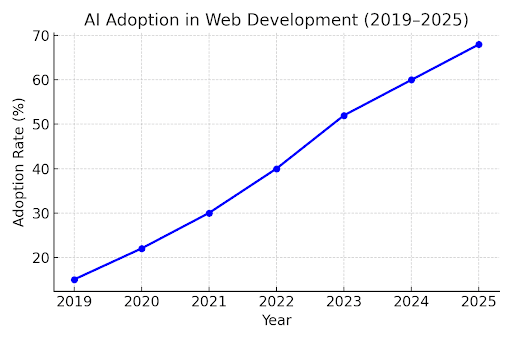
This growth reflects the shift from AI being an optional “innovation experiment” to a core productivity tool in development workflows. The steep rise between 2022 and 2024 aligns with the widespread release of affordable AI coding assistants and low-code/no-code AI platforms.
2. Top Benefits Driving AI Integration (2025 Survey)
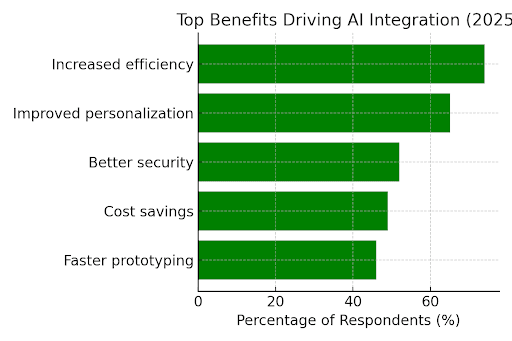
The data shows that while cost savings are important, productivity gains and user experience improvements are the real motivators behind AI adoption. Developers are increasingly using AI to streamline repetitive coding, improve UI/UX, and proactively address security vulnerabilities.
3. AI Tool Usage Breakdown
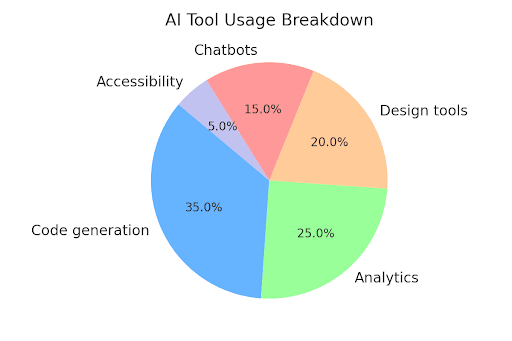
The dominance of AI-powered code generation reflects developers’ desire to speed up production without sacrificing code quality. Interestingly, AI accessibility tools still have the smallest share, suggesting a major growth opportunity in that space as compliance regulations tighten.
4. Common Challenges in AI Web Development
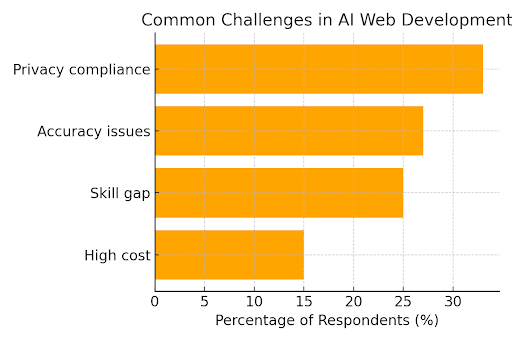
Privacy compliance is the most pressing issue — especially in industries handling sensitive data. Accuracy concerns follow closely, reinforcing the need for human oversight even when AI tools are integrated deeply into the workflow.
Future Outlook for AI in Web Development 2025:
The story of AI in web development is still in its early chapters. As we move into the second half of the decade, several transformations are poised to reshape how we think about websites, user experiences, and even the role of developers themselves.
1. Fully Automated Front-End Development
Within a few years, we may see AI handling 90–100% of routine front-end work. Developers will transition from writing code line-by-line to curating, validating, and customizing AI-generated designs.
Imagine describing your brand’s tone and audience in plain language — and within minutes, an AI system generates a fully functional, accessible, and responsive site, complete with optimized SEO structure and integrated analytics.
2. Adaptive AI Websites
Future websites won’t just display static content; they’ll reshape themselves in real time. A returning visitor might see a completely different homepage layout based on their browsing history, purchase patterns, or even the weather in their city. This kind of personalization will extend beyond product recommendations into dynamic design adaptation — where even font sizes, colors, and interactive elements adjust automatically.
3. AI in Decentralized Web
As blockchain-based infrastructure grows, AI will play a critical role in making decentralized apps (dApps) more user-friendly. Expect AI to:
- Streamline blockchain transaction flows for non-technical users
- Analyze on-chain data for fraud prevention
- Assist with smart contract generation and auditing
This convergence of AI and Web3 could be the next big leap in how secure, transparent, and adaptive web services become.
4. Hyper-Personalized Accessibility
Regulatory frameworks are tightening worldwide, and AI will become the compliance partner for ensuring digital accessibility. Soon, an AI could instantly detect accessibility gaps and auto-correct them without human intervention — making web experiences more inclusive without adding heavy manual workloads.
5. Voice-First Web Navigation
As voice assistants mature, expect voice-native websites where users can navigate, transact, and consume content without ever touching a screen. AI will be the engine behind natural language understanding, multi-lingual support, and adaptive content delivery in these voice-first environments.
The Future Belongs to AI-Augmented Creativity
AI is not here to erase the role of developers — it’s here to elevate it. The web teams that thrive will be those that embrace AI as a collaborator, not a competitor.
At Trreta Techlabs, we help businesses and developers harness AI to create faster, smarter, and more secure websites. Whether you’re exploring AI for the first time or looking to upgrade your existing systems, our team can guide you through strategy, implementation, and optimization.Contact us today to discover how AI can transform your web presence into a dynamic, future-ready platform.
FAQs
1. Will AI replace web developers entirely?
Not anytime soon. AI will handle repetitive, predictable tasks, but human oversight will remain essential for creativity, strategic decision-making, and ethical considerations.
2. How do you start integrating AI into my web development workflow?
Begin with small, measurable applications — such as AI-powered code completion, chatbot integration, or design automation — before moving into full-scale AI adoption.
3. What are the biggest risks of AI in web development?
The main risks include privacy compliance issues, over-reliance on AI-generated outputs, and potential bias in machine learning models. Always pair AI tools with clear data governance policies.
4. Is AI-driven personalization worth the investment?
Yes — when implemented well. AI personalization can increase user engagement, retention, and conversion rates, but it requires high-quality data and a solid content strategy.
5. How can AI improve website security?
AI can detect unusual traffic patterns, identify suspicious login attempts, and predict potential vulnerabilities before they are exploited — making it a proactive security asset.
6. What skills will developers need in an AI-dominated environment?
Beyond coding, developers will need AI literacy, data analysis skills, and prompt engineering abilities to guide AI outputs effectively.
7. How expensive is AI integration for small businesses?
Costs vary, but entry-level AI tools are becoming increasingly affordable. Many SaaS AI solutions offer subscription models starting under $50/month.
8. How do I ensure my AI web development is ethical?
Follow transparent AI practices, audit your models for bias, and give users clear opt-in/opt-out choices for data collection.
